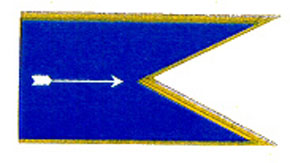Civil War Facts |
Colonial Wars |
American Wars |
Link To This Page — Contact Us —
XVII Corps Civil War Facts

| The XVII Corps was organized December 18, 1862, under the same order which created the XV and XVI Corps. It was composed of the divisions of Logan, McArthur and Quinby,-- formerly the 3rd, 6th and 7th Divisions of Grant's Army, --and Maj. Gen. J. B. McPherson was assigned to its command. It was engaged in the operations on the Mississippi River prior to the campaign in the rear of Vicksburg, and then took a prominent part in the series of battles which resulted in the investment of that place. Its 3 divisions entered | XVII Corps Flag  |
Logan's Division was engaged at the battle of Port Gibson (Magnolia Hills), where it lost 6 killed, 41 wounded, and 2 missing; also at Raymond, where it was the only division in action, losing there 66 killed, 339 wounded, and 37 missing. At the battle of Jackson, May 14th, the brunt of the fight fell on the XVII Corps and on Quinby's Division, which lost 36 killed, 229 wounded, and 3 missing; total, 268. Gen. Quinby being absent on account of illness, his division was commanded there by Gen. Crocker. At Champion's Hill, both Logan's and Crocker's Divisions were engaged, losing in the aggregate 179 killed, 857 wounded, and 42 missing; total, 1,078. During these battles, McArthur's Division had been absent on duty, but joined the corps in time for the first assault on Vicksburg, May 19, in which it lost 16 killed and 113 wounded. In the general assault of May 22d, the corps lost 150 killed, 880 wounded, and 36 missing; total, 1,066. It also sustained a severe loss in the trenches during the siege, and was engaged in the affair at Fort Hill, a strong earth-work in front of the corps position. This fort was successfully mined and blown up, June 25th, but the assaulting column was unable to retain their lodgment in the crater. Upon the surrender of Vicksburg, Logan's Division was accorded the honor of first entering and occupying the city, while the rest of the corps marched away with Sherman's Expedition against Jackson.
That place having been captured, the Army returned to Vicksburg, where, in September, 1863, the 4th Division of the XVI Corps (formerly Lauman's) was transferred to the XVII Corps, and placed under command of Gen. M. M. Crocker. At the same time, Quinby's Division was transferred to the XV Corps. During the fall of 1863, the corps took part in various raids and marches, and in February, 1864, Crocker's and Leggett's Divisions accompanied Sherman's Army on the expedition from Vicksburg to Meridian, Mississippi, and on the return. Soon after this the corps became divided, 2 divisions joining Sherman's Army in the advance on Atlanta, while the rest of the corps remained in the Mississippi Valley.
In May, 1864, the 3rd and 4th Divisions were assembled at Huntsville, Alabama, from whence they marched through Georgia, and joined Sherman's Army on the 8th of June, at Ackworth, Ga. The corps was under the command of Maj. Gen. Frank P. Blair, Gen. McPherson having been promoted to the command of the Army of the Tennessee, which comprised the XV, XVI, and XVII Corps. Blair's 2 divisions--the ones with Sherman's Army--were commanded by Gens. Leggert and Gresham, the latter officer succeeding Gen. Crocker, who relinquished his command, May 27th, on account of ill health. Although Sherman's Army was well on its way to Atlanta, there was plenty of hard fighting left for the XVII Corps. It was engaged with honor in the battle of Atlanta, July 22nd, which was one of the hardest contested fields in that campaign. Gen. Gresham was badly wounded in this action, and Gen. Giles A. Smith succeeded to the command of the 4th Division. After the fall of Atlanta, Fuller's Division of the XVI Corps was transferred to the XVII Corps, becoming its 1st Division, to the command of which Gen. Joseph A. Mower was soon after assigned.
While on the "March to the Sea" Campaign, and during Sherman's march through the Carolinas, the corps remained under the command of Gen. Blair, with its 3 divisions--1st, 3rd, and 4th--under Gens. Mower, Leggett, and Giles A. Smith.
Just before starting on the "March to the Sea", its morning reports showed 11,732 present for duty; it then contained 32 regiments of infantry and 5 light batteries. It encountered little or no fighting as it went marching through Georgia, but its advance through the Carolinas was marked by several minor engagements, culminating in the battle of Bentonville in which it was partially engaged. There were long, toilsome marches, also, with wide rivers to cross and swamps to wade, many of which were forded under the Confederate fire.
After participating in the Grand Review at Washington at the close of the war, the Army of the Tennessee--XV and XVII Army Corps--was ordered in June, 1865, to Louisville, Kentucky. On the 6th of July, orders were issued to prepare the Army of the Tennessee for muster-out; in a few weeks the ranks which had fought at Donelson, Shiloh, Corinth, Vicksburg, Atlanta, and in the Carolinas, moved northward and disappeared.
When the XVII Corps started on the Atlanta campaign it left the 1st and 2nd Divisions in the Mississippi Valley, and the corps thus separated was not reunited. The place of the First Division was filled at Atlanta by the transfer from the XVI Corps; the place of the 2nd Division remained vacant, for that division continued to serve in the Department of the Mississippi as a part of the XVII Corps. Six regiments from this division served on Banks' Red River Expedition in April, 1864, the 6 regiments -- formed into 2 brigades-- being known then as a Provisional, or as the Red River Division of the XVII Corps. It was commanded by Gen. T. K. Smith. Parts of this division served, also, on McArthur's Yazoo City Expedition, May 4:-13, 1864:, and on Gen. Slocum's Expedition to Jackson, July 5-6, 1864. A few regiments were engaged, also, under Sturgis, at Brice's Cross Roads, and in Gen. A. J. Smith's Expedition to Tupelo. The fighting in some of these campaigns was severe on certain regiments.
In November, 1864, the Red River Division of the XVII Corps accompanied Gen. A. J. Smith's forces to Nashville, and took part in that famous battle and victory. Smith's troops consisted of 2 divisions of the XVI Corps and this provisional division of the XVII; but the whole command was officially designated as a "Detachment, from the Army of the Tennessee," instead of by their corps numbers. Upon the reorganization of the XVI Corps, prior to the Mobile campaign of 1865, this division of the XVII Corps was merged in the larger organization of the Sixteenth; hence, the XVII Corps, in 1865, consisted of the 3 divisions then marching with Sherman northward through the Carolinas.
Major Battles Fought In
|
|
